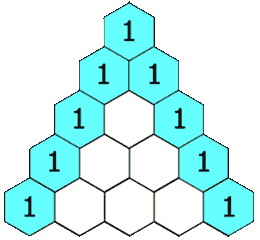Pascal's simplex facts for kids
Pascal's simplex is a fascinating mathematical idea. It takes the familiar Pascal's triangle and stretches it into higher dimensions. Think of it as a way to organize numbers in a more complex shape than a flat triangle.
Contents
What is Pascal's Simplex?
Pascal's simplex is a special arrangement of numbers, much like Pascal's triangle. However, instead of being a flat, two-dimensional triangle, Pascal's simplex exists in more dimensions. It helps us understand how numbers relate to each other in a more complex way.
From Triangle to Simplex
To understand Pascal's simplex, it helps to first look at two key ideas: what a simplex is, and what Pascal's triangle is. Pascal's simplex combines these two concepts.
What is a Simplex?
A simplex is a basic shape in geometry. It's like a building block for more complex shapes.
- A 0-simplex is just a single point.
- A 1-simplex is a line segment connecting two points.
- A 2-simplex is a triangle, made by connecting three points.
- A 3-simplex is a tetrahedron, which is a pyramid with four triangular faces.
- A 4-simplex and higher dimensions are harder to imagine, but they follow the same pattern. Each simplex is the simplest shape you can make with a certain number of points in a given dimension.
What is Pascal's Triangle?
Pascal's triangle is a famous pattern of numbers. It starts with a "1" at the top. Each number below is found by adding the two numbers directly above it. If there's only one number above, you just bring that number down.
For example:
- Row 0: 1
- Row 1: 1 1
- Row 2: 1 2 1 (1+1=2)
- Row 3: 1 3 3 1 (1+2=3, 2+1=3)
Pascal's triangle is useful for many things, like finding the coefficients in binomial expansions (like in (x+y)² = 1x² + 2xy + 1y²). It also shows the number of ways to choose items from a group, which is called combinations.
Building Pascal's Simplex
Pascal's simplex takes the idea of Pascal's triangle and expands it. Instead of just adding numbers in a flat triangle, you add numbers in a multi-dimensional structure. Imagine building a pyramid of numbers, or even more complex shapes.
Dimensions of the Simplex
- The 0-simplex (a point) is just the number 1.
- The 1-simplex (a line) is like the rows of Pascal's triangle, but along a line: 1, 1 1, 1 2 1, and so on.
- The 2-simplex (a triangle) is exactly Pascal's triangle itself.
- The 3-simplex (a tetrahedron) is like a pyramid of Pascal's triangles stacked on top of each other. Each layer is a Pascal's triangle, and the numbers in the pyramid are found by adding the three numbers above them (in a triangular pattern).
As you go to higher dimensions, the simplex becomes more complex. The numbers within Pascal's simplex are related to combinatorics, which is the study of counting and arrangements. They represent the number of ways to choose items from a set, just like in Pascal's triangle, but for more complex situations.
Where is Pascal's Simplex Used?
Pascal's simplex is a concept in advanced mathematics. It is used in areas like:
- Combinatorics: It helps in counting arrangements and combinations in higher dimensions.
- Probability: It can be applied to problems involving multiple choices or events.
- Algebra: It relates to the expansion of expressions with more than two terms (like (x+y+z)ⁿ).
- Computer science: Some algorithms and data structures can be understood using these multi-dimensional patterns.
While it might seem abstract, Pascal's simplex is a powerful tool for mathematicians to explore patterns and relationships in numbers beyond what we can easily see in two or three dimensions.


